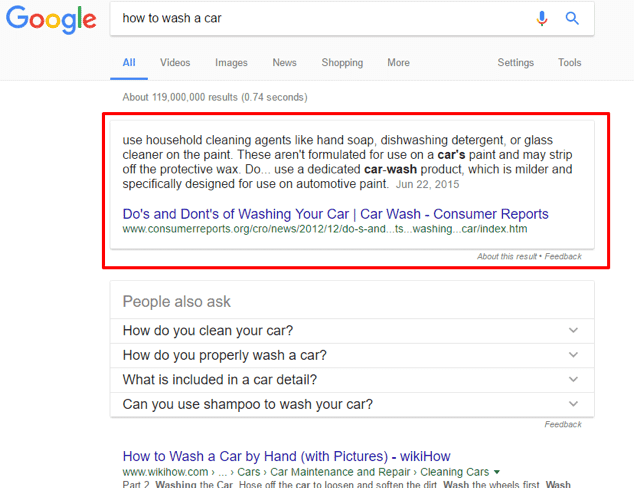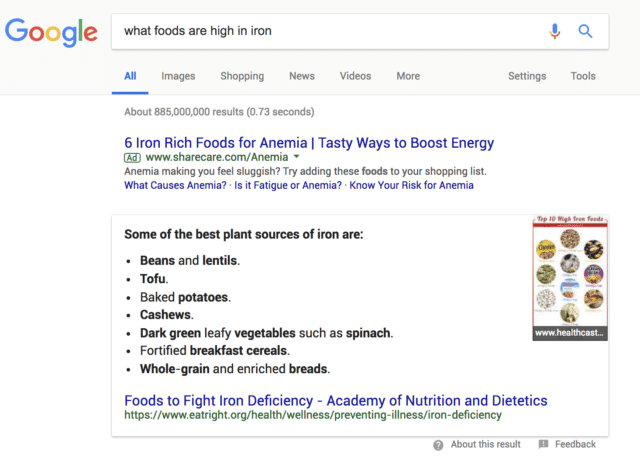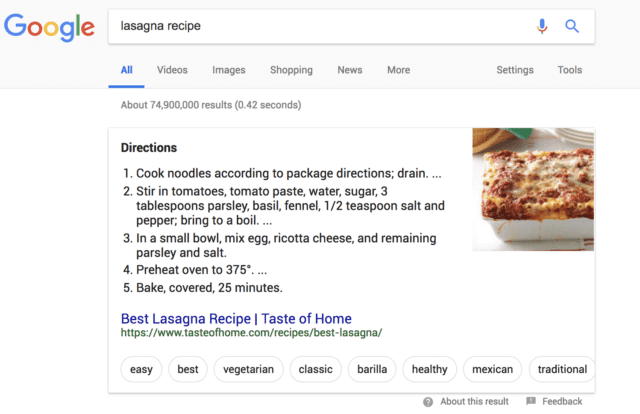Perhaps you’ve noticed that when you type a phrase or question into Google search, you’ll often see a box at or near the top of the search results attempting to answer that question for you without your having to hunt around for relevant links.
This is called a “featured snippet.”
Below is an example of a basic featured snippet you might find while searching “how to wash a car” in Google:

Featured snippets come in many different forms. Sometimes they are just a paragraph excerpt (as seen above), or sometimes they’re in list form (below).

Another common type is the recipe featured snippet, which typically shows the first few steps in a recipe with a link to the full recipe. This type of featured snippet also sometimes displays buttons at the bottom of the box that allows users to narrow down the type of recipe they’re searching for. For example, in the lasagna featured snippet below, you have the choice to search further for vegetarian lasagna or Mexican lasagnas:

“But wait — will users even bother to visit my site if they can get what they need without leaving Google?”
While a featured snippet does allow a user to find a quick answer without clicking through to the site, research shows that (a) users actually do click through quite often, and (b) the snippet tends to collect the vast majority of clicks on a results page. According to study results compiled by Moz, websites featured in these snippets experienced the following:
- Click-throughs quadrupled on average (2 percent to 8 percent)
- Traffic increased 20-30 percent
- Resulting revenue from organic traffic increased as much as 677 percent
Suffice it to say, you want to get your site inside a featured snippet if at all possible. The nagging question is how?
Alas, as with most aspects of Google — it’s basically up to Google. However, there are specific ways to create and organize content within your page that can make your site easier to be discovered, indexed, and correctly categorized by Google’s search engines, which can greatly increase your chances of appearing in a featured snippet. Some of it is technical, but most of it is plain old common sense. Let’s look at some best practices to help you frame your content in the best light.
1. Answer questions people are asking
In recent years, especially with the advancements in mobile technology and voice commands, people are changing the way they engage with Google search, moving from keyword strings to voice commands, such as “Siri, where are some good restaurants near me?” or “Alexa, how do I unclog my sink?”
Search engines are rapidly adapting to voice queries, and today, they tend to favor high-quality content that directly provides answers to these types of questions. In other words, if your content contains concise information that directly answers the question “How do I unclog my sink?” you have a much better chance of landing in a snippet box when a user asks that question. Here are some steps to aim you in the right direction:
- Begin with traditional keyword research. Good Q&A will still contain relevant keywords.
- Expand those keywords into common question formats. Tools like Answer the Public can be quite useful here. Google search results also provide helpful intel under many featured snippets with a secondary box of expandable content called “People also ask”.
- Focus on topics and keywords where your site already ranks well. No sense in reinventing the wheel. Play to your own strengths whenever possible.
2. Use structured data
Once you have content that is conducive to being picked up in a featured snippet, another technique that can improve your chances is the use of structured data. Google defines structured data as “a standardized format for providing information about a page and classifying the page content.” In simpler terms, structured data is coding within the page that helps Google recognize the page context, structure, and relevance more easily. In the examples of featured snippets earlier in this post, did you notice how a lot of them featured numerical and bullet lists? That’s an example of structured data.
Here are some tips for incorporating structured data into your content:
- Ask a question and answer it. A good basic format is to format the question in an <h> subheader tag, provide a concise answer beneath it, and expand on the answer in subsequent paragraphs.
- Use lists when appropriate. Lists (using sets of <ol> and <li> tags) can be quite useful for DIY instructions like how-to tutorials and recipes. Google loves to put lists inside snippet boxes.
- Organize content logically. If your page contains multiple questions and answers on the same topic (which is a good practice), make sure everything makes sense and is relevant.
3. Write for people first
Optimizing for voice search and structuring your data can be incredibly valuable, but it’s important to note that there are no guarantees. You can “do everything right,” yet Google may still pass you up. In fact, Moz indicates there is even some debate as to whether structured data is mandatory to landing a featured snippet (although it certainly can’t hurt your chances).
When it comes down to it, your best bet for becoming more visible in Google search results is to provide rich, high-quality, relevant information that your readers or customers are looking for. And if you’d like expert guidance in optimizing your site for better visibility, partnering with a trusted WordPress support company can help you implement the right strategies and technical improvements to increase your chances of earning featured snippets.



